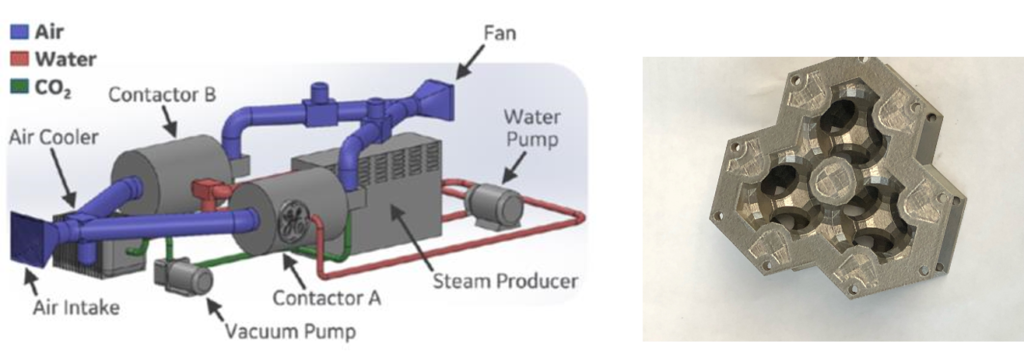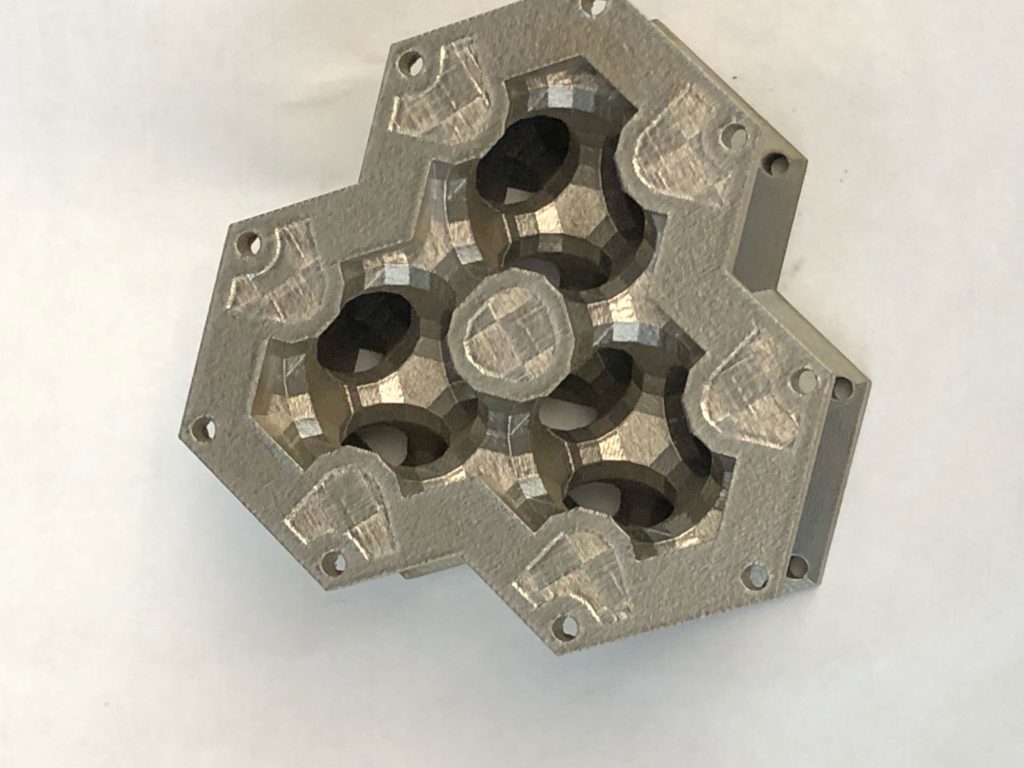The U.S. Department of Energy (DOE) is betting on still very nascent carbon capture technology to attempt to address runaway global warming and it’s turning to GE to do so. Along with chemists and engineers from UC Berkeley and the University of South Alabama, GE Research has been selected for a two-year project to develop a method for direct air capture (DAC) of carbon dioxide (CO2). The DOE has awarded the team $1.5 million, with a $500,000 cost share from GE and its partners.
The project involves the use of a 3D printed heat exchanger made with materials for absorbing CO2 from the air. The process is similar to a separate GE project funded by the Defense Advanced Research Projects Agency (DARPA) for extracting water from the air. The specifics of how that technology works hasn’t been detailed, other than that it will rely on a carbon absorbing material. GE will be 3D printing heat exchangers meant for optimizing temperature management within the carbon extraction system to maximize the process.

A diagram depicting a direct air capture machine alongside a 3D printed heat exchanger. Image courtesy of GE Research.
The UC Berkeley group, led by Professor of Chemistry Omar Yaghi, is focused on the sorbent materials themselves, having researched this area since the mid-90s.
“Since the first crystallization and proof of porosity of metal-organic frameworks in 1995 and 1998, respectively, we have been continually developing their chemistry and design on the atomic/molecular scale,” Yaghi said.

A 3D printed heat exchanger like this one could be used to optimize temperatures in a DAC system. Image courtesy of GE Research.
The University of South Alabama team, under the guidance of Prof. Grant Glover, will be dedicated to determining the materials for the overall system. help inform the selection of the right materials for the system.
Glover said, “Metal Organic Frameworks (MOFs) provide an exciting opportunity to design materials to separate gases. With the opportunity to pair these insights with the GE team that has expertise in manufacturing and product development, the possibilities of what we can bring to CO2 capture are quite exciting.”
David Moore is the Principal Investigator and Technology Manager for Material Physics and Chemistry at GE Research. Moore explained that, by combining UC Berkeley’s knowledge of sorbent materials and University of South Alabama’s sorption modeling, and testing with GE’s own expertise in materials, thermal management and 3D printing, the team will work to develop a unique system for DAC.
“Through this project, we’re aiming to demonstrate the feasibility of a system that could become a future large-scale, economical solution for widespread decarbonization of the energy sector,” Moore said.
The GE Research project is just one of four new endeavors dedicated to DAC that received a total of $6 million from the DOE’s Office of Fossil Energy and Carbon Management (FECM). Georgia Institute of Technology will also be using 3D printing to create a modular DAC system with Oak Ridge National Laboratory, which has already researched the use of 3D printing for carbon capture. Altogether, the DOE is funding 10 total DAC projects with $12 million so far as a part of the U.S. government’s goal of achieving net zero emissions by 2050.
Surely, 3D printing will play a role in optimizing a wide variety of designs for new energy technologies, but the fact that the DoE is investing so heavily in DAC is troubling, to say the least. The most important reason is that the planet needs to reduce CO2 emissions by at least 55 percent of 1990 levels by 2030 in order to prevent the climate from becoming so out of balance that it leads to irreversible changes to the ecosystem that could end life on earth.
At the moment, DAC is an almost non-existent technology, meaning that, while it could have some potential in the distant future, should be more of a backup method for reducing atmospheric CO2. Instead, it is necessary to immediately reduce carbon emitting activities and keep fossil fuels in the ground. However, even if it were to develop at the necessary scale, there are a number of issues to consider, such as the fact that DAC could use up a quarter of the world’s energy by 2100, essentially exacerbating our existing overuse of energy rather than reducing it.
Other issues include the fact that we don’t know if we could roll out such a technology at the proper scale quickly enough to address the climate emergency. Carbon Brief put it this way, in looking at a study related to DAC:
“Reaching 30GtCO2/yr of CO2 capture – a similar scale to current global emissions – would mean building some 30,000 large-scale DAC factories,” the paper says. For comparison, there are fewer than 10,000 coal-fired power stations in the world today.
“If DAC were to be carried out using small modular systems, then as many as 30m might be needed by 2100,” the paper says. “It compares this number to the 73m light vehicles that are built each year.”
There are numerous other reasons to put DAC lower on the priority list when it comes to addressing global warming, ranging from the possibility of leaks and the fact that it incentivizes existing fossil fuel companies to maintain their existing infrastructure.
Subscribe to Our Email Newsletter
Stay up-to-date on all the latest news from the 3D printing industry and receive information and offers from third party vendors.
You May Also Like
3D Printing Financials: Fathom Struggles in Financial Quicksand During Critical Transition
Facing a year of key transitions and financial pressures, Fathom (Nasdaq: FTHM) has filed its annual report for 2023 with the U.S. Securities and Exchange Commission (SEC). The document outlines...
Latest Earnings Overview for Australian 3D Printing Firms Titomic and AML3D
Australian 3D printing manufacturing firms Titomic (ASX: TTT) and AML3D (ASX: AL3) reported their financial results for the period from July to December 2023, marking the first half of their...
3D Printing Webinar and Event Roundup: April 7, 2024
Webinars and events in the 3D printing industry are picking back up this week! Sea-Air-Space is coming to Maryland, and SAE International is sponsoring a 3D Systems webinar about 3D...
3D Printing Financials: Unpacking Farsoon and BLT’s 2023 Performance
In the Chinese 3D printing industry, two companies, Farsoon (SHA: 688433) and Bright Laser Technologies, or BLT (SHA: 688333), have recently unveiled their full-year earnings for 2023. Farsoon reported increases...































